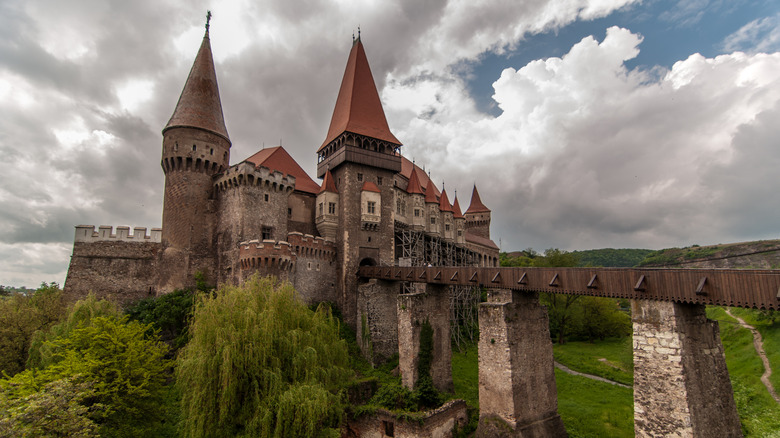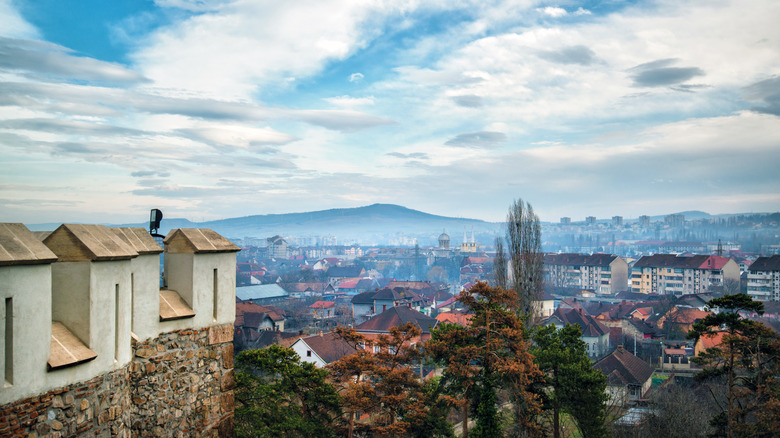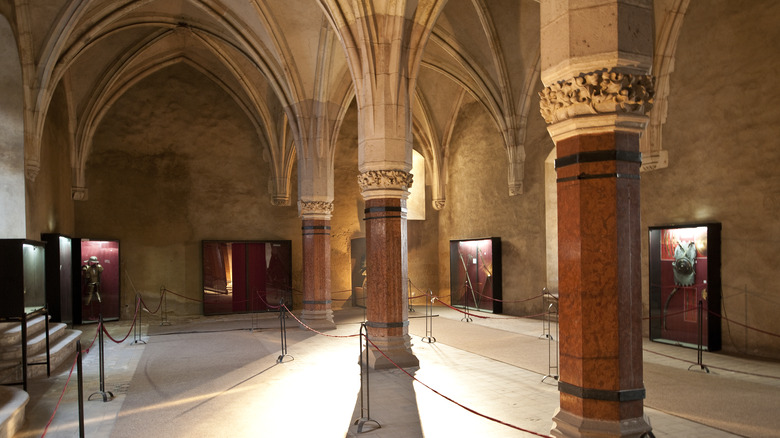One Of Europe's Largest Castles Is A Romanian Wonder With History That Spans Centuries
There are many fairytale castles in Europe, but none is as impressive or legendary as Corvins' Castle. The dreamy castle is the largest in Romania and arguably the most beautiful in Europe. It is located in Hunedoara, southwest Transylvania, a two-hour drive from Cluj-Napoca. It's about six hours from the Romanian capital, Bucharest, known as the "Little Paris of the East."
The massive 15th-century castle complex, called Castelul Corvinilor in Romanian, was built in the Gothic-Renaissance style with multiple towers and soaring spires protected by boulder walls and a cinematic draw bridge over a moat. It's located above River Zlaști, overlooking the town of Hunedoara. Adorned with tapered arch windows, intricate stone carvings, and gorgeous glass windows, the centuries-old castle evokes stories of knights and princesses. Corvins' Castle is also known for its most famous prisoner, Vlad the Impaler, a historical character who inspired Bram Stocker to create the bloodthirsty Count Dracula for his 1897 horror novel. The castle is halfway between Bucharest and Budapest, so add it to your bucket list during your Central European road trip!
The colorful and complex history of Corvins' Castle
Also known as Hunyadi Castle or Hunedoara Castle, records on the original dates of construction and the castle's first owner are conflicting in historical accounts. Many accounts say that the Holy Roman Emperor, Sigismund, King of Hungary, gave the castle to his loyal general, Voyk de Hunedoara, in 1409 as compensation for his military leadership. His son, John Hunyadi (Hunedoara in the Roman language), requested further construction of the magnificent structure, expanding a keep built by Charles 1 of Hungary. John Hunyadi was a brave military leader who fought against the Ottoman Empire and prevented the Turkish invaders from occupying Christian land in the 15th century. He initially built the castle as a defense fortress and a prison, and eventually added to the property and turned it into a scrumptious palace with areas for feasts and ceremonies.
The juicier version of the castle's history involves an illicit love affair and a stolen treasure. According to legend, Sigismund gave Voyk de Hunedoara more than just the castle — he also gave Voyk his lover as his wife. The woman, Elisabeta Morsina, was pregnant with Sigismund's child, and because Sigismund did not want her to be dishonored, he arranged for her to be married to Voyk, one of his most loyal knights. The child was John Hunyadi. The king gave a gold ring to his lover so the unborn child could claim his place in the court. One day, a raven stole the gold ring during a family outing. Young John, the illegitimate child of King Sigismund, shot down the bird with his bow and retrieved the ring. Therefore, the raven with a gold ring in its beak became the family symbol. John's son, Matthias Corvinus, the King of Hungary, changed his name from Hunedoara to "Corvin," derived from "Corvus"—the Latin word for raven. The castle retains his name to this day.
The castle witnessed the complex story of the land that changed hands from the Romans to the Hungarians, who were under constant siege by the Ottomans. This captivating castle represents a significant part of Medieval European history and is a must-see while visiting Romania, an underrated and hauntingly beautiful country.
Highlights of a storybook castle with a dark history
The Knight Hall, where knights and noblemen feasted, has a dramatic vaulted ceiling and sturdy marble columns. Up the spiral staircase is the equally impressive Diet Hall, used for ceremonies and receptions. The grand chapel is where the tomb of John Hunedoara lies near a gorgeous stained-glass portrait of Joan Corvinus de Huniad, Matthias Corvinus' son.
The ancient castle is shrouded in mystery and many ghost stories. Near the ticket kiosk is a museum that displays torture devices used during Medieval times. The Capistrano Tower, named after a Catholic Priest who once lived there, was used as a prison. The Neboisa Gallery is an open-air, suspended corridor that connects to the Capistrano Tower. Its name, Neboisa, dubbed by the mercenary members of the castle garrison, means "do not fear" in Serbian. In one of the courtyards is a 94-foot well dug into stone by three Turkish prisoners. Allegedly, John Hunedoara promised the prisoners their freedom if they found water. They finally found water after 15 years and 28 days. However, the king died in the time since he made the promise, and his wife executed them.
Grimness aside, climb to the top of Corvins' Castle, where the spires are decorated with colorful tiles. You can admire the drawbridge from above and enjoy the panoramic view of the tranquil village and the surrounding area. You might even be able to see a wedding or two, as this storybook castle is a popular spot for couples to begin their lives together.


